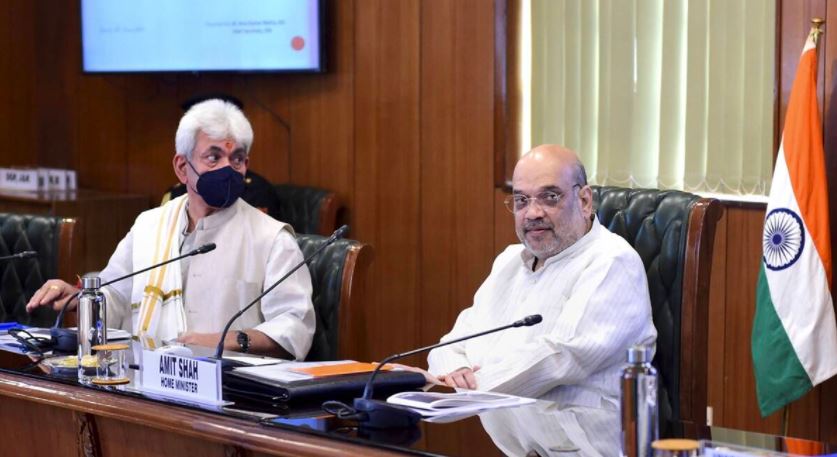The Centre, on the subject of Jammu and Kashmir and its future, has been sending out feelers for quite some time now. All sorts of rumours are circulating on social media – ranging from the possibility of India moving to regain control over Pakistan occupied Kashmir (PoK), to the Union Territory being bifurcated into two territories. Many have been suggesting that Jammu be made a separate state with a legislature. Some have also called for Kashmir to be split further into two halves – divided between Ladakh and Jammu. The Centre has not been very open about its future J&K agenda, but we now have a fair idea of what it is.
Earlier this month, the delimitation commission for the Union Territory of Jammu and Kashmir had kicked off the exercise by writing to all 20 District Commissioners, seeking basic demographic, topographic information as well as the local administration’s impressions of political aspirations of the district. The Union Territory’s delimitation commission is headed by retired Justice Ranjana Prakash Desai and was formed in February last year.
Effectively, the delimitation has now physically begun in Jammu and Kashmir, and the delimitation commission will soon prepare a report based on which the assembly and Lok Sabha constituencies in the Union Territory will be redrawn. A preliminary report of the latest inputs which the commission has received may very well be presented during the Prime Minister Narendra Modi-led crucial all-party meeting with the political parties of Jammu and Kashmir.
The meeting on June 24 between the different parties of Jammu and Kashmir and the top leadership in Delhi is said to have the delimitation process as the centre point of discussions. According to the Indian Express, sources in the security establishment said, “Things have settled down in Kashmir. Developmental works are in progress. Security situation is under control. It is only fair to reach out to political parties.”
Interestingly, the delimitation process is being hastened since the Centre is said to be keen to conduct the assembly elections in the union territory of Jammu and Kashmir soon. The source told the Indian Express that the elections being announced soon should not come a surprise, and added, “Yes, it is likely the process may be hastened and it may be achieved by the end of 2021. But in any case, it will happen only after the Delimitation Commission submits its report.”
Now, with delimitation in full swing in the Union Territory, the Centre will push for giving Jammu more electoral and legislative representation both in the UT’s assembly, as well as the Lok Sabha. The representation of Hindus in a fair manner and on an equal footing with Kashmiri legislators has been long overdue, and the Centre finally seems to be taking steps towards that end. Kashmir region with its higher number of seats has always dominated state politics.
Jammu and Kashmir has a total of 111 constituency segments out of which 24 seats are designated for the territorial constituencies of the state that were administered by Pakistan in 1947. These seats remain officially vacant as per section 48 of the state constitution. Therefore only 87 seats are filled or contestable in the Jammu and Kashmir assembly. Out of these 87 seats, the Kashmir valley region has 46 seats and the Jammu region has 37 seats. Four seats belonged to Ladakh – but that is now a separate Union Territory.
Read more: Is J&K finally getting a Hindu CM? Well, the starting of delimitation exercise in J&K suggests so
With delimitation, the number of seats will be increased, and there is a good chance that Jammu might play a dominant role in the Union Territory’s assembly in the near future. This would be a huge setback for the political parties of Kashmir, and especially for the leaders of the two Kashmiri families who have monopolised the erstwhile state’s politics for decades.
Another agenda on the Modi government’s mind might be that of the resettlement of Kashmir Pandits – who were made to flee their homelands during the religious exodus of Hindus from Kashmir in the 1990s by Islamists. Of course, for this effort to bear fruit – the push must come from Kashmiri Pandits themselves, and not the government.
Finally – the Modi government can also bifurcate Jammu and Kashmir into two territories, although the same is very unlikely. Nevertheless, if a bifurcation does happen, it will create a Muslim-only state/UT in the form of Kashmir – a scenario, which should ideally be avoided.
There is another scenario, which is doing the rounds – and chatter does suggest that it is not as unlikely as the bifurcation of Jammu and Kashmir. This involves granting statehood to Jammu and Kashmir, which means it would no longer remain a Union Territory. Granting statehood to Jammu and Kashmir right now is not ideal. Terrorism must be completely weeded out of the region before the statehood is granted back.
Rest assured, anything which is supposed to happen in Jammu and Kashmir will be out of the scenarios mentioned by us. Despite the Modi government’s appetite to surprise people, on this count, we are fairly certain nothing astronomically out of the box is awaiting India.
